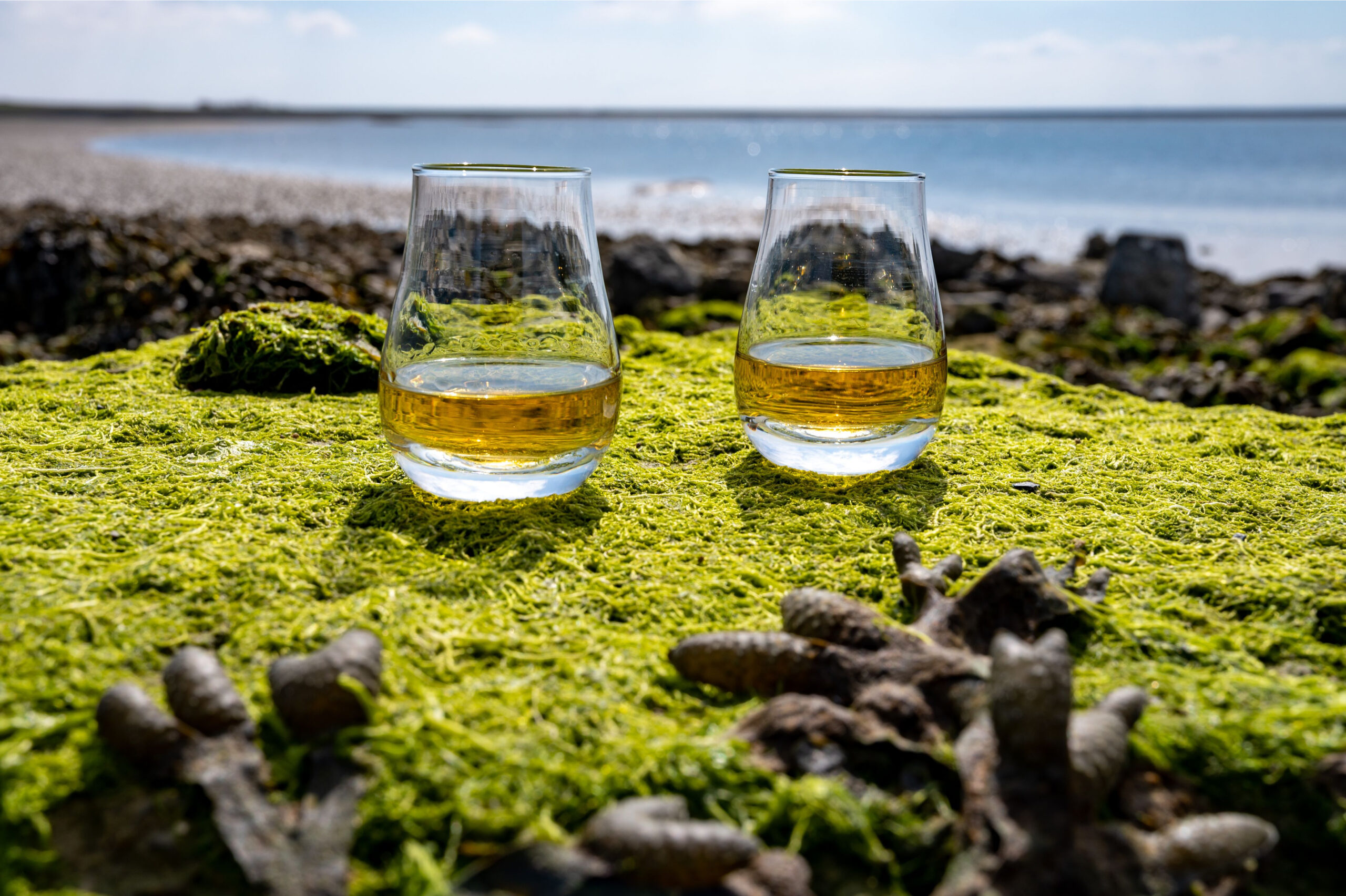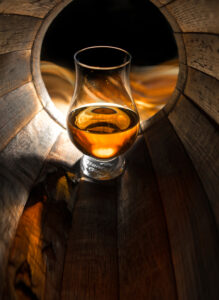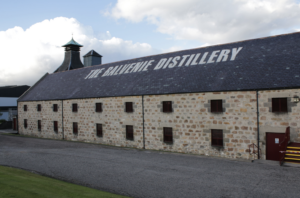Distilling 60 years of whisky stories

In any wisely organised universe, a writing project for a whisky brand would involve much tramping through heather, gazing up at Scottish hillsides, admiring trickling burns, walking over ancient cobblestones, pushing through creaking warehouse doors, tiptoeing past sleeping casks and, you would hope, tasting a dram or two.
Last spring, lockdown put paid to the dream distillery visit. But although I was tethered to London throughout, this did develop into a dream writing project.
Celebrating a 60 year career in whisky
It all started when Francesca Tenenbaum, then at Here Design, asked me to discover and distil 60 years of stories to accompany a 60 year old whisky celebrating the 60 year career of David C Stewart, Malt Master at the Balvenie.
The Balvenie is a small whisky distillery in Speyside, Scotland, part of the William Grant & Sons family business that also produces Glenfiddich. It’s distinctive in that it’s the only distillery in Scotland that still grows its own barley, uses traditional floor maltings and has a coppersmith and a team of coopers on site.
Here Design has a long association with the Balvenie. The agency created extraordinary packaging for the Balvenie 50YO, featuring 50 layers of hand-crafted wood to represent the 50 years that the whisky had matured in the cask.
A lifetime written in whisky
My task was to interview people from the Balvenie, including David, and gather anecdotes, discoveries and memories from his extraordinary career. Elements of these stories would be etched onto the bottle and five outer glass layers, a lifetime of memories expressed in words.
60YO whiskies are extraordinarily rare, and only 71 bottles would be created, filled from one cask dating from 1962.
As Francesca said, the result goes far beyond packaging and into the realm of sculpture. As far as I can tell there must have been more than a touch of magic to produce the five ultra-fine layers of curved glass, etched in gold, that surround the bottle of 60YO whisky.
Gathering stories
David was a fascinating person to interview. Over two and a half hours on Zoom, he talked to me about his career with William Grant & Sons, from the art of managing whisky stocks to his many inventions over the years.
I also talked with Kelsey McKechnie, the new Malt Master at the Balvenie, Brian Kinsman, Master Blender at William Grant & Sons, Dennis McBain, Coppersmith, Ian McDonald, Master Cooper, Gemma Paterson, Balvenie Global Ambassador, and David Mair, Ambassador at the Balvenie. All were wonderfully generous in sharing their time and stories.
This video gives an idea of some of the stories that were chosen to represent David’s life in whisky.
Looking into a crystal ball
On the video, you can make out a few snippets from the stories I gathered. The first is about the year that David started at the Balvenie.
“In 1962 a young David C Stewart began working as a whisky stocks clerk for the Balvenie. In this same year, a collection of traditional European oak hogshead casks were filled with new make spirit. As the months and years passed, this young clerk proved to have a rare talent. As he continued to learn new skills, the resting whisky continued to mature.”
Although it was accidental that David started in the whisky stocks department, it turned out to be highly significant.
As Gemma Paterson, Balvenie Global Ambassador, told me: “David was learning not just about the profile of whisky and the art of blending, but the complex beast that is the whisky stocks model. That team is a crystal ball. You have to look into the past, see what stock is laid down, think about the present, everything that’s being produced today and filled, and then project into the future and try to predict demands based on how the industry will be in 10, 20, 50 years’ time.”
Magic and mystery in the cask
In the New Yorker, Lawrence Osborne wrote about the Balvenie, commenting: “They say that the most beautiful alcohol creations last about as long as human beings. At twenty, they’re vigorous but unformed; at fifty, they are beginning to hit an otherworldly stride.”
Gemma Paterson agrees with Lawrence. She says: “Casks are porous and the whisky is constantly breathing and evolving within the cask. When a whisky is matured for 50 or 60 years, these liquids will often be unidentifiable as whisky as we know it, because something magical and mystical happens in the cask that we don’t fully understand. It almost goes beyond whisky.
“The Scottish Whisky Research Institute has a department that studies these things, but nobody can say exactly what happens in the cask.”
Divining the history of the 1962 cask
Thanks to his extraordinary nose and immense understanding of whisky making, David is able to hazard a guess at how many times the 1962 cask had been filled before.
“We don’t know the history of some of these casks from the 60s,” he said. “But I’m guessing it might be on its third filling because the whisky isn’t overly oaky for 60 years.
He added: “We’re very lucky that the quality of the cask is good. Even 50, 60 years ago, we were putting our whisky in great quality casks, although we didn’t know an awful lot about wood back then.”

The best type of glass for whisky tasting is the Glencairn, where the tuliip shape allows the whisky to breathe
Time travel through whisky
It’s rare for anyone who isn’t a Malt Master to have the opportunity to taste a really old whisky. And when people do get the chance, it tends to be a moment when time stands still.
“When we released the Balvenie 50YO, it put people in a kind of trance,” said David Mair, Balvenie Ambassador. “We held an event in New York with two 50YO casks. It was a noisy room full of people, but when we started the tasting, the room fell silent. It was like one of those old cowboy movies where everyone goes quiet when someone walks through the swing doors.
“Nobody could speak. We were all thinking, ‘Do we deserve to drink this?’ It’s remarkable that we can put our lips to a liquid that was made five decades ago by people who have long since passed away.
“The very, very, very few people who will get to taste the 60YO are incredibly lucky and I hope that when they do taste it, they find it heavenly.”
So how does it taste?
Let’s ask the man who knows. “The whisky’s got quite a floral perfumed aroma, rose petals, all these lovely flavours you sometimes don’t associate with Balvenie. Maybe it’s partly because back then the stills were coal-fired, whereas today they’re heated by steam coils.
“Maybe it’s a combination of the spirit or the actual cask the whisky’s been put in, but it’s created a lovely Balvenie, slightly different from what you might expect.”
Someone else who was fortunate enough to taste the 60YO at its launch in October is Pritesh Mody, Founder at World of Zing Bottled Cocktails and TV Cocktail Presenter on Channel 4 Sunday Brunch. He says: “I’ve been lucky enough to try some super aged spirits in my time and most of it is story over drinkability. THIS however was utterly incredible – rich, smooth, layered and lingering.”
The rest of us can only imagine.

The Balvenie distillery: I haven’t been there, yet…
The long-postponed trip to Speyside
Now that we’re free to travel again, I hope to make it to Dufftown before long to see the distillery in real life. In the meantime, I’d like to congratulate David on 60 years in the business. As the 60YO is a little beyond my reach, I’ll be raising a glass of 21YO PortWood to David instead. Slàinte Mhath!
More about my work
Read about:
- The Longest Serving Malt Master – a post on the Balvenie website that includes more quotes from my story gathering odyssey.
- The harp and writing workshop that I developed and subsequently delivered for the people at Here Design during lockdown.
- What I learned from a writers and wine workshop at the Museum of Wine in Bordeaux.